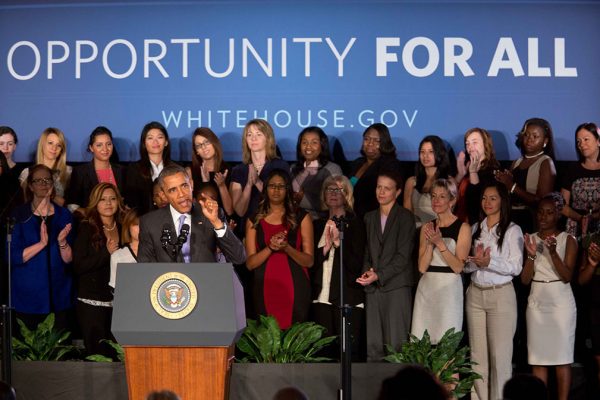Jacob Hacker and Paul Pierson convincingly describe a new Democratic Party—one with economic policy priorities that are more progressive than they’ve been in decades. Remarkably, the party has made this transition while hemorrhaging working-class voters and running up their margins among the highly educated, affluent suburbanites who once would have decried Bidenomics as creeping socialism.
Hacker and Pierson have a clever answer to those who worry that passing more ambitious redistributive reforms will be difficult without alienating their increasingly upscale base. The ironic silver lining of America’s extreme wealth inequality, they say, is that Democrats can count on all the money they need to fund expansive economic policies by taxing only the very rich. What’s more, they argue, Democrats are exhibiting remarkable message discipline—at least on social media—designed to play up their focus on “pocketbook” issues and avoid potentially polarizing divisions around race and other contentious issues.
This argument is among the most plausible I have read of how the Democrats might forge a durable majority in the medium term. At the same time, there are several areas where the analysis misses or understates the difficulty of the Democrats’ road ahead, particularly with respect to working-class voters. I will briefly address three: the gap between Democrats’ commitment to progressive economic policies and their messaging to voters on the campaign trail, the party’s general aversion to populist rhetoric, and the strategic dilemma that Democrats face in their communication around controversial cultural issues.
The Platform-Campaign Disconnect
In a departure from their legislative agenda and social media messaging, economic issues do not feature nearly as prominently in Democratic campaigning. Indeed, a forthcoming analysis from the research group I direct, the Center for Working-Class Politics, reveals that in the nearly eight hundred TV ads released by Democrats in competitive House districts in 2022, candidates invoked abortion three times more often than any primarily economic issue. (Dobbs, which overturned Roe v. Wade, was decided in June that year.) Of the twenty top-used phrases in these ads, only three were not about abortion, and those highlighted Social Security or Medicare—not the policies Hacker and Pierson discuss.
Looking at the key themes of the ads, we find a similar pattern. While 30 percent focused on some sort of economic issue (ranging from good jobs to lowering prescription drug and consumer costs), the other 70 percent prioritized abortion, resistance to Trump and Republican extremism, or individual candidate qualities. Only 18 percent of the ads mentioned jobs; fewer than 2 percent mentioned good jobs (whether high-paying, or unionized, or those that pay a living wage), and related issues like manufacturing jobs and job training programs were virtually absent. Even Biden’s own signature economic policies barely registered: candidates were 6.5 times less likely to mention the Inflation Reduction Act, the CHIPS Act, the Infrastructure Investment and Jobs Act, and so on than to mention abortion. If you get your information about Democrats’ priorities from this sort of messaging to voters, rather than from social media or C-SPAN, you’d have little reason to conclude the party cared much about economics. What good are bold economic ambitions—especially those meant to “build power through policy”—if the party doesn’t tell voters about them?
True, Democrats exceeded expectations in 2022. This has a lot to do with the fact that many working-class voters also care deeply about defending abortion rights, but it is unclear whether a similar strategy will work again in 2024 and beyond. Democrats’ underwhelming emphasis on economics—especially the absence of language touting large-scale jobs programs and other kinds of “predistribution” policies meant to decrease inequality in the market—may have serious consequences for the party’s credibility among the working-class voters they desperately need to maintain majorities in swing states like Michigan, Wisconsin, and Pennsylvania.
Put Some Feeling into It!
Even if Democrats were placing expansive economic policy front and center in every medium, they face a challenge that limits the efficacy of their outreach to working-class voters. Most Democratic politicians are allergic to populist language—the sort that draws a sharp divide between ordinary, working-class Americans and rapacious economic and political elites.
When delivered effectively, strong populist appeals can help candidates connect more viscerally with the economic pain and suffering felt by so many Americans in our era of historic inequality. Take the sort of populist language that United Auto Workers President Shawn Fain has used to great effect over the last year. “We fight for the good of the entire working class and the poor,” he has said, decrying the “billionaire economy.”
By contrast, only around 20 percent of Democratic ads in competitive 2022 House races called out economic elites in any way. Fewer than 5 percent mentioned billionaires, the rich, Wall Street, big corporations, or price gouging, and fewer than 5 percent invoked pro-worker phrases such as “working families,” “working people,” or “unions”—even though about a fifth of ads included visual depictions of working-class people. Whatever the pro-redistributive policy preferences of Democratic leaders may be, they are not translating into campaign rhetoric that lets working people know that Democrats hear them and are looking out for their economic interests.
Culture War Neutrality?
Finally, Hacker and Pierson stress that, contrary to much popular perception, Democrats simply aren’t focusing on controversial racial, social, or cultural issues—at least besides abortion. A forthcoming analysis by the Center for Working-Class Politics lends further support to this view: we find that Democrats’ favorable use of what has been decried as “woke” language—from “Defund the Police” to “Abolish ICE”—is exceedingly rare.
Yet even though the party is steering clear of polarizing culture war issues, very few Democrats deliberately distance themselves from such topics, as commentators like John Judis and Ruy Teixeira have urged them to do. In fact, in our analysis of over 900 Democratic congressional candidates in 2022, we were able to identify only 12 who explicitly chastised or condemned any kind of progressive cultural language or policies on their campaign websites. It is possible that this neutrality contributes to some voters’ perceptions that Democrats are too focused, or at least too “soft,” on divisive issues.
That said, even when recent candidates like Ohio’s Tim Ryan have tried to put as much light as possible between themselves and the activist left—in his case, by running a TV ad that showed him throwing a football at a monitor displaying the phrase “Defund the Police”—they haven’t been particularly successful (though to be fair, Ryan did substantially outperform Biden in Ohio). Of the ten Democratic candidates in competitive House races who explicitly condemned “Defund the Police” in TV ads in 2022, just four won their races, all of whom were incumbents: Sanford Bishop (GA-2), Jared Golden (ME-2), Marcy Kaptur (OH-9), and Dan Kildee (MI-8).
The upshot is that it’s not clear how meaningful it is that Democrats don’t talk about controversial cultural issues; their silence seems to have little connection to how voters perceive them. Further, our research suggests that avoiding the cultural issues that Democratic base voters care about may even hurt Democrats—by suppressing enthusiasm or turnout among their progressive supporters. One path out of this dilemma could be to combine messaging on such issues with stronger, much more consistent messaging on economics. More of the latter could allay working-class voters’ concerns about their interests being ignored, though it remains unclear whether this would be enough to cut through the right-wing media’s effective portrayal of Democrats as “cultural Marxists.”
In sum, Hacker and Pierson make a compelling case that Democrats have come a long way on economic policy since the bad old days of the Democratic Leadership Council and Clinton’s declaration that the era of big government was over. But this transformation will mean little if their outreach to voters continues to portray the party as out of step with the working-class communities Democrats need to make their vision a reality.
Boston Review is nonprofit and relies on reader funding. To support work like this, please donate here.






